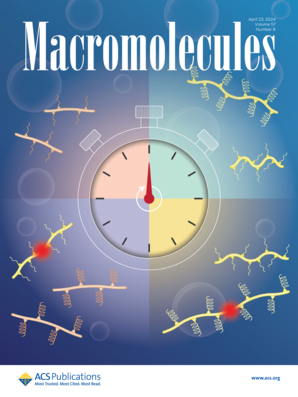Height-Switching of Active Polymers in Binary Polymer Brushes
IF 5.1
1区 化学
Q1 POLYMER SCIENCE
引用次数: 0
Abstract
Modifying surface properties by polymer brushes is very important in polymer science. The surface properties of binary polymer brushes can be changed by switching the height of one of the two polymers. In this study, the height-switching of the active polymer in a binary polymer brush composed of active and passive polymers was investigated through Langevin dynamics simulations. The active polymer was modeled as a copolymer consisting of an active head possessing a self-propelled force with magnitude Fs and a subsequent passive block. Both the active polymer and passive polymers were end-grafted onto a surface that exhibits an attraction to the active polymer but pure repulsion to the passive polymers. The active polymer is adsorbed on the surface at low Fs while it is desorbed at large Fs. The alteration of the state of the active polymer leads to the reversible height-switching of the active polymer, specifically, the switch between the immersed state of the active polymer beneath the polymer brush at small Fs and the exposed state of the active polymer protruding out of the polymer brush at large Fs. The dependence of the critical self-propelled force Fs* for this height-switching on the length of the active polymer and the grafting density of the polymer brush was investigated. The results show that active polymers have significant potential as candidates for smart polymer brushes.

二元聚合物电刷中活性聚合物的高度开关
高分子刷修饰表面性质在高分子科学中具有重要意义。通过改变其中一种聚合物的高度,可以改变二元聚合物刷的表面特性。本研究通过朗之万动力学模拟研究了由主动和被动聚合物组成的二元聚合物电刷中活性聚合物的高度开关。该活性聚合物被建模为由具有f级自推进力的主动头和随后的被动块组成的共聚物。将活性聚合物和被动聚合物端接枝到一个表面上,该表面对活性聚合物具有吸引力,而对被动聚合物具有纯粹的斥力。活性聚合物在低Fs时被吸附在表面,而在高Fs时被解吸。活性聚合物状态的改变导致活性聚合物的可逆高度切换,特别是,在小Fs处活性聚合物在聚合物刷下的浸入状态和在大Fs处活性聚合物突出在聚合物刷外的暴露状态之间的切换。研究了这种高度转换的临界自推进力f *与活性聚合物的长度和聚合物刷的接枝密度的关系。结果表明,活性聚合物作为智能聚合物刷的候选材料具有很大的潜力。
本文章由计算机程序翻译,如有差异,请以英文原文为准。
求助全文
约1分钟内获得全文
求助全文
来源期刊

Macromolecules
工程技术-高分子科学
CiteScore
9.30
自引率
16.40%
发文量
942
审稿时长
2 months
期刊介绍:
Macromolecules publishes original, fundamental, and impactful research on all aspects of polymer science. Topics of interest include synthesis (e.g., controlled polymerizations, polymerization catalysis, post polymerization modification, new monomer structures and polymer architectures, and polymerization mechanisms/kinetics analysis); phase behavior, thermodynamics, dynamic, and ordering/disordering phenomena (e.g., self-assembly, gelation, crystallization, solution/melt/solid-state characteristics); structure and properties (e.g., mechanical and rheological properties, surface/interfacial characteristics, electronic and transport properties); new state of the art characterization (e.g., spectroscopy, scattering, microscopy, rheology), simulation (e.g., Monte Carlo, molecular dynamics, multi-scale/coarse-grained modeling), and theoretical methods. Renewable/sustainable polymers, polymer networks, responsive polymers, electro-, magneto- and opto-active macromolecules, inorganic polymers, charge-transporting polymers (ion-containing, semiconducting, and conducting), nanostructured polymers, and polymer composites are also of interest. Typical papers published in Macromolecules showcase important and innovative concepts, experimental methods/observations, and theoretical/computational approaches that demonstrate a fundamental advance in the understanding of polymers.
 求助内容:
求助内容: 应助结果提醒方式:
应助结果提醒方式:


